
Almanac
Colombia, Republic of
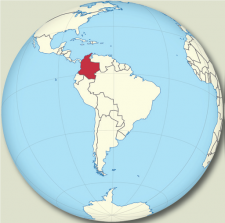
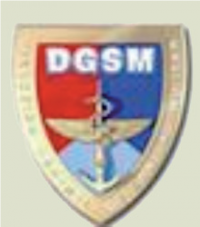
Surgeon General
Javier Alonso Díaz Gómez
Major General
Avenida Calle 26 No 69 - 76, Torre Tierra(3), Piso 4
Bogotá D.C.
COLOMBIA
Pictures and Graphics: Wikimedia Commons
Basic Task of the Military Medical Service
The Military Health Subsystem of Colombia’s Forces is an agency of the Ministry of National Defense that provides health services to military staff on active duty, retired and their dependents. Likewise, the mission is to support military operations on land, sea, river and air of the Military Colombian Forces deployed throughout the national territory, providing a comprehensive health service. Those actions are aimed at strengthening operational health, health promotion, disease prevention, recovery and rehabilitation, in order to improve the quality and lifestyle of the staff under their responsibility. The provision of health services is developed under a model with a risk approach and comprehensive health care with quality attributes to its users.
For military personnel, the Operational Health is an essential part of Military Health Subsystem because it provides a continuum of care in all the dimensions of well-being related with physical and mental health, which allows for compliance with the physical standards of the commissioned officers, non-commissioned officers (enlisted) and soldiers in the armed forces to deal with military operations.
This is done by an analysis of health risks of the theatre of operations, taking as described in the current regulations (Health in Campaign, Naval and Diving Medicine, and Aerospace Medicine), intervening the risks through the three main axes in Operational Health (Appreciation and Analysis, Medical Planning and Medical Logistics in operational health), based on research and continuing education of health personnel involved in health care.
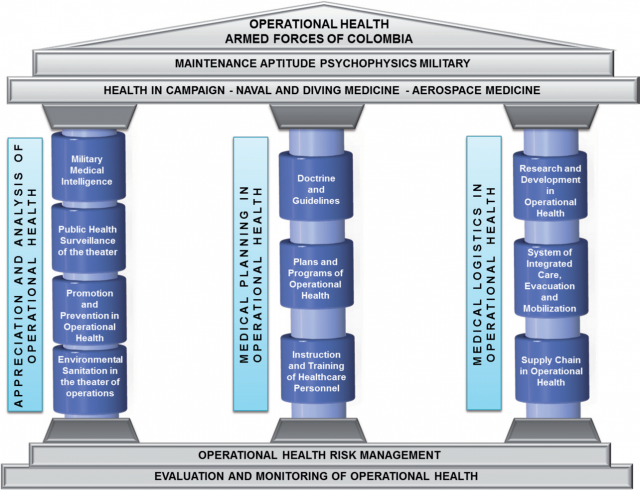 Methodological scheme for risk
management of operational health
Methodological scheme for risk
management of operational health
Source: Ministry of Defence Colombia
Structure
The Strategic Management, monitoring, evaluation and continuous improvement of activities in operational health is developed by the Directorate General of Military Health, based on the generation of guidelines in health that are deployed in the Departments of Health of the Army, Navy and Air Force, according to the specific operating conditions of each Force, through call centres or military health establishments willing nationwide.
The Departments of Health of each Force, behave as a forwarder of the guidelines, because they have the resources and human talent needed, qualify for cover the health care requirements of the approximately 681,000 users of the Military Health Subsystem, where 254,381 are military personnel on active duty.
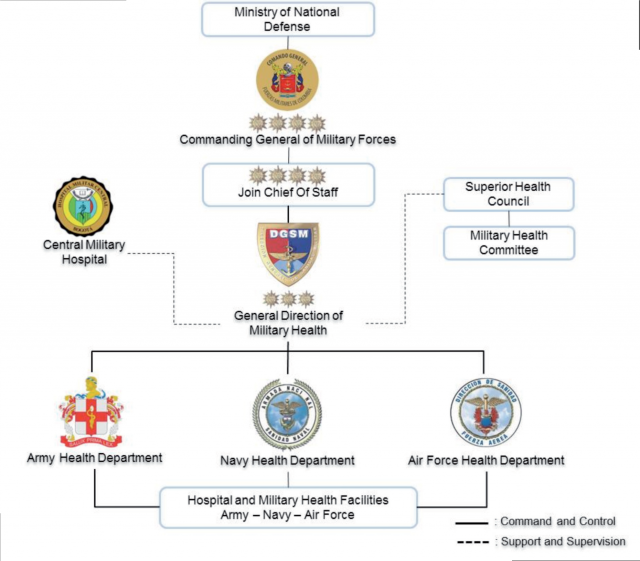 Structure of the Health System
of the Military Forces of
Colombia
Structure of the Health System
of the Military Forces of
Colombia
Source: Ministry of Defence Colombia
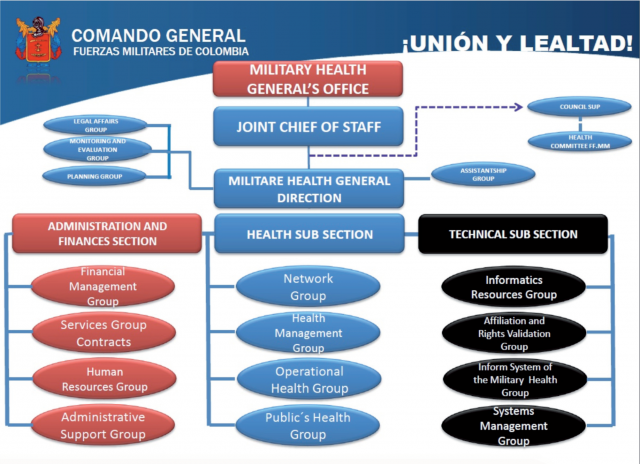 General Direction of Military Health
General Direction of Military Health
Source: Ministry of Defence Colombia
Military Hospitals and Military Health Facilities
Nowadays, the main objective of military health in the theatre is to preserve the combat manpower of the Armed Forces. This mission is accomplished by providing an efficient and functional health care system, perfectly jointed and integrated since the very moment when military personnel are wounded or sick in the theatre of operations, through the successive stages of prehospital medical care until a hospital facility that can provide definitive care and rehabilitation for the injury/disease-specific, in a timely manner secure, efficient, coordinated between the branch and the National Personnel Recovery Center - CNRP, showing a functional integration work and rational use of resources.
Support of other military health establishments strategically located and higher levels of complexity is received. These are the regional hospitals, which have the technical and scientific capacity to support care resulting from exposure to the operating environment and health services for the target population (household).
As a complement to the structure of health care provided, the Central Military Hospital, which has the higher-level response capacity, intended to provide a full range of medical and specialized services with extensive experience in managing the war trauma.
Training for assistant/nursing personnel
The General Direction of Military Health in coordination with the Departments of Health in the Forces (National Army – National Navy – Colombian Air Force), leads the organization and development of the course “Instructor of Military Rescuer”, which is aimed at military staff in the area of the primary responsibilities of health. The course focuses on increase the teaching skills by Instructor of Military Rescuer, in order to strengthen the core competencies of an instructor by using methodological tools such as workshops and practical exercises to strengthen knowledge and explore different techniques to optimize the process training. This personnel are trained like Instructor of Rescuer Military will prepare militaries who conduct activities as first responder health in trauma war, providing immediate aid and assistance in health, too sick or injured persons in the field of military operations.
In 2016 intensity of course is increased, the methodology has been perfected as well as improved logistics for the course development. The advancement of this course, allowed between 2014 and the first half of 2016 have been trained 151 non-commissioned officers as instructors, who have trained 3,110 soldiers belonging to the operational units of the Armed Forces of Colombia.
The challenges continue in the new scenario we expect from peace negotiations, in which the Military Forces of Colombia must continue to fulfil its mission, intervening new phenomena of crime and represent a threat to security. The Military Rescuers are those who continue to provide care personnel involved in the development of military operations. The General Direction of Military Health will continue training personnel for the effective response to the care needs in the multiples theatres of operations that arise.
Field Deployments
Since 2002, is deployed nationwide the Advanced Trauma Life Support Airborne Group – GATRA (for his initials in Spanish) in response to the offensive of the military forces against the drug-terrorist organizations.
The philosophy of the Advanced Trauma Life Support Airborne Group is summarized in the organization of an interdisciplinary health group accompanying military operations, with resilience and mobilization of human resources, materials and equipment, allowing prompt attention of vital emergency, damage control surgery and preparation for the transport and evacuation of wounded personnel in a timely manner, to a health establishment of a higher level of complexity, or external network hospitals, according to their medical requirements.
Successes in saving lives have identified this group as an important part of integrated care, medical evacuation and transfer system, which articulates with the National Personnel Recovery Center (CNRP) and the Military Health Establishments of the third level of care, external network hospital and/or Central Military Hospital, in order to optimize the use of available resources and capacity, reducing mortality and subsequent sequels in the injured personnel into combat with it.
The tactical evacuation procedure (CASEVAC) and medical evacuation (MEDEVAC) prior assessment of the health status of the patient is performed. The development of such missions often requires coordination between the three branches, in order to provide the most suitable land, water or air environment, taking into account the medical condition of the injured soldier and operational status of the area where the patient is located. Search and rescue missions in a normal situation (SAR) or under fire (CSAR) are performed; these missions are carried out by operational units of the National Army, National Navy or Colombian Air Force. During the past few years, the armed forces have been strengthened with pressurized and unpressurized medicalized aircraft which conditioned exclusively for transferring patients from around the country, with greater range and speed for commuting, which are intended for use as air ambulances, which have onboard specialized aeromedical transport with high-tech equipment, complying with the human resources requirements stipulated by law. Also, with exclusive destination the UH60L helicopters and utility aircraft like the C-90, C-130, C-295s and CN-235b.
In the last decade, they have made 12,241 mobilizations of military and 2,664 civilian patients for a total of 14,905 transferees who have been victims of armed conflict, natural disasters and medical emergencies.
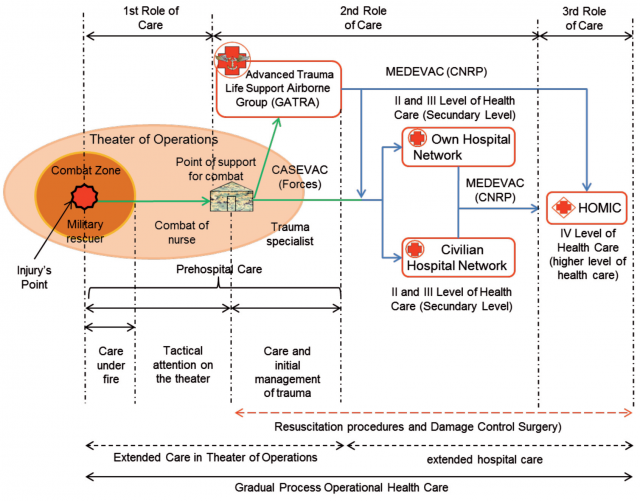
Source: Ministry of Defence Colombia
Civil-Military Cooperation
Civil-military cooperation made by the Military Health of the Armed Forces of Colombia has been evident in the developed successful national and international tasks, such as humanitarian aid missions in the Haiti earthquake in January 2010 level and the humanitarian emergency in the earthquake in Peru in August 2013. The experience gained by the Colombian military doctors in the care of trauma patients has allowed them to work together with their counterparts from the US, Canada and Israel, in field hospitals organized by these countries in disaster areas.
During the earthquake that occurred in Ecuador in 2016, the Armed Forces supported the aeromedical transport the wounded bound for hospital and homeless destined to major cities in southern Colombia. Similarly, basic care team supported the work of the aid station ambulatory care established by the disaster relief entities sent for the National Government of Colombia.
Army 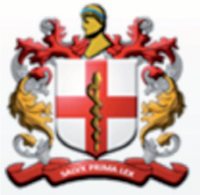
Surgeon General
John Arturo Sánchez Peña
Brigadier General
Director de Sanidad Ejército
Source: Ministry of Defence Colombia
Air Force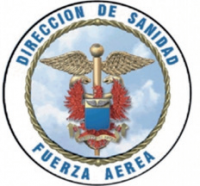
Surgeon General
Lina Maria Mateus Barbosa
Colonel MC
Director de Sanidad Fuerza Aérea
Source: Ministry of Defence Colombia
Navy
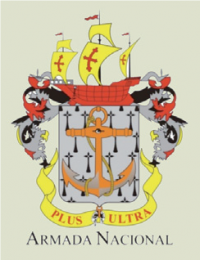 Surgeon General
Surgeon General
Germán Arango Jaramillo
Naval Captain
Logistics Officer – National Armed Forces
Dirección de Sanidad Naval
Carrera 13 N° 26-50, Edificio Bachué 5° Piso
Bogotá D.C.
COLOMBIA
Source: Ministry of Defence Colombia
Basic Task of the Military Medical Service / Vision
Mission: The Directorate of Health of the National Armed Forces coordinates the provision of care and operational health services in promotion, prevention, recovery and rehabilitation for members and beneficiaries of the military forces health subsystem, by means of its military healthcare facilities.
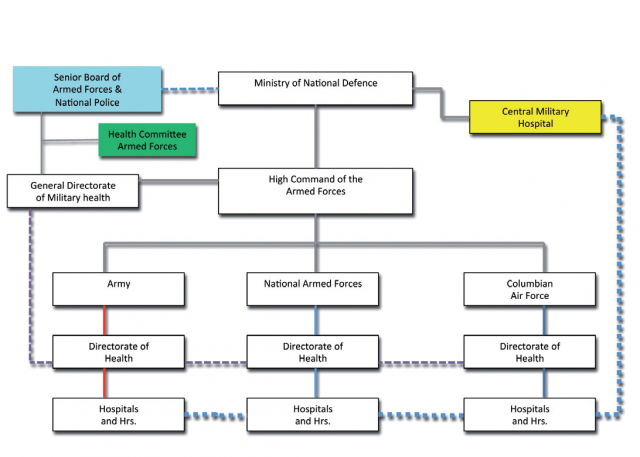 Surgeon General (Organization / command structure)
Surgeon General (Organization / command structure)
Source: Ministry of Defence Colombia
Vision: For the year 2014, the Directorate of Naval Healthcare and its establishments will adopt a care and operational model that will focus on the risk and integral care proposed by the General Directorate of Military Health, conforming to the quality attributes defined by the provision of healthcare services, to the members and beneficiaries of the military forces health subsystems.
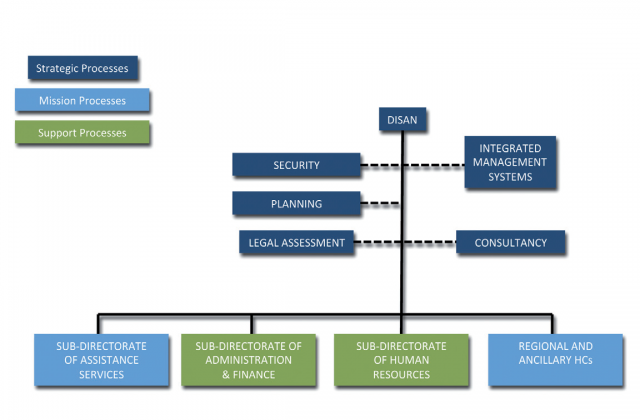 Military Medical Service (Organization / command structure)
Military Medical Service (Organization / command structure)
Source: Ministry of Defence Colombia
Military Hospitals
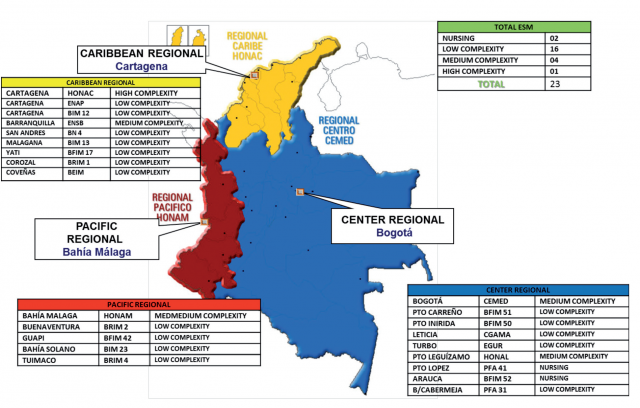
Source: Ministry of Defence Colombia
Number of Medical Facilities
| STAFF SPECIALITY / CATEGORY | MILITARY | RURAL | CIVIL ARC | CIVIL DGSM | TOTAL | |
| GPs | 37 | 48 | 13 | 98 | ||
| SPECIALIST DOCTORS | 42 | 40 | 82 | |||
| GENERAL DENTISTS | 13 | 33 | 8 | 54 | ||
| SPECIALIST DENTISTS | 14 | 5 | 19 | |||
| BACTERIOLOGISTS | 8 | 22 | 7 | 37 | ||
| PSYCHOLOGISTS | 30 | 4 | 34 | |||
| NURSES | 23 | 14 | 37 | |||
| OTHER HEALTH PROFESSIONALS | 34 | 34 | ||||
| SPECIALIST GPs | 11 | 11 | ||||
| SPECIALIST DENTISTS | 3 | 3 | ||||
| NURSING AUXILIARIES | 444 | 61 | 505 | |||
| DENTAL AUXILIARIES | 23 | 23 | ||||
| ELECTROMEDICINE | 4 | 4 | ||||
| LABORATORY AUXILIARIES | 0 | 5 | 5 | |||
| X-RAY TECHNICIANS | 6 | 1 | 7 | |||
| ADMINISTRATIVE STAFF | 20 | 17 | 16 | 53 | ||
| ADMINISTRATIVE-TECHNICAL AUXILIARIES | 29 | 88 | 117 | |||
| TOTAL | 661 | 126 | 17 | 319 | 1123 | |
During 2014, five officials completed medical specialisation in the areas of paediatrics, psychiatry and internal medicine, five medical officers began specialist training in general surgery, gynaecology, family medicine and paediatrics, one odontologist started specialist training in periodontics and one doctor started particular specialisation in intensive care, thereby strengthening the health team's qualifications for providing high-quality health.
Regional Medical Facilities
Naval Hospital de Cartagena
This currently comprises a hospital area with a total of 105 beds, external consultation with 41 offices, clinical laboratory, blood bank and pathology, diagnostic imaging, 5 operating rooms, an adult intensive care unit with 7 beds (4 in intensive care and 3 in intermediate care), emergency area, hyperbaric chamber, physiotherapy and rehabilitation area.

Bahia Malaga Naval Hospital
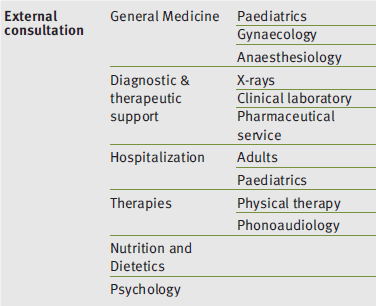
Naval Medicine Centre
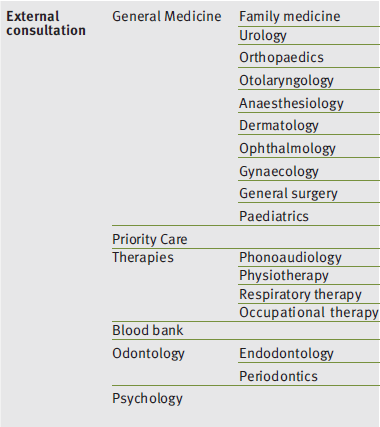
Training
Training for medical officers, dentists, bacteriologist and psychologists takes place in specialisms relating to each profession. Specifically, medical specialities are studied in the Military University of Nueva Granada (Bogotá), whose practical centre is the central military hospital. Senior officers are seconded to this university for their studies. Professional health service staff undertake coordinated training accredited by the AHA (American Heart Association) in advanced adult and child resuscitation, and in Advanced Trauma Life Support (ATLS) accredited by the American College of Surgeons. Our nurses undertake training in Pre-hospital trauma life support (PHTLS) accredited by the National Association of Emergency Medical Technicians. Each year, the Naval Directorate of Health trains officers, NCOs and marines in battle trauma first aid, medical planning and intelligence via courses in combat nursing and becoming medical technicians, with the aim of dealing with wounds and injuries in the theatre of operations. In the course of 2014, it will train 550 men as medical technicians and 100 combat nurses. Due to this training there is expected to be a medical technician for every 10 men and a nurse for every 40 men in the front line. Similarly, 2015 is planned to include the first international training for medical technicians, which is expected to see participation from a number of South American countries.
Field Deployments
Treatment chain for wounded soldiers
The removal and evacuation of wounded and sick personnel from the theatre of operations to the closest medium or high complexity health care facility, depending on the patient's clinical condition, is coordinated horizontally between the commanders of the land and fleet units, managers of health centres (HCs), regional managers, naval aviation operation managers, army aviation or Air Force, with these movements immediately notified to the Directorate of Naval Healthcare. Should the patient need to be transferred with help from Naval Aviation or the Colombian Air Force, the HCs' medical officers justify the requirement for the air transfer, the aircraft type and the need for medical accompaniment during the move directly to the head of naval aviation operations. These communications are made by telephone, satellite or other official communication methods (unit operation centres, force operation centres and National Army Command operation centres).
The procedures described apply exclusively during the removal, evacuation and transportation of staff who become injured or sick during the course of military operations.
Civil-Military Cooperation
In those regions of the country where no military health centre of medium or high complexity care is available, hospitals within the external civil network are contracted to care for the different conditions that require specialist care. The Columbian National Armed Forces, in coordination with the Peruvian Armed Forces, annually undertake bi-national operations, with the primary aim of bringing healthcare to 108 townships in the departments of Putumayo and Amazonas, benefiting approximately 10 000 civilians. Three Columbian naval officers participate in this operation within the specialisms of general medicine, dentistry, bacteriology and equally they rely on the naval nursing services that provide care in vaccination, promotion and prevention. Similarly, during 2014, the Colombian Armed Forces frigate “ARC Almirante Padilla” participated in the RIMPAC operation, in which 23 nations carried out exercises with the aim of strengthening their capacity for humanitarian disaster relief, maritime control and complex naval operations in the areas of antisubmarine warfare, surface warfare, anti-air combat and amphibious operations. One medical officer took part in the operation as part of the crew, to handle any medical situation during the operation.
Other Special Aspects
Investment plans (2015–2018)
The Naval Directorate of Health, as part of its 2015–2018 investment plan, allocated a total amount of resources of 75 590 000 000 pesos, with the aim of improving the infrastructure of 18 military healthcare facilities, increasing the capacity to provide health care by implementation of the tele-medicine programme at a national level, the acquisition of a new hyperbaric chamber for the Cartagena Naval Hospital as well as construction of its administrative centre and the acquisition and commissioning of the paediatric ICU and neonatal ICU, along with the acquisition of an ambulance launch and an intelligent operating room. This plan also includes the acquisition of an intelligent operating room for the Barranquilla healthcare facility and refurbishment of the odontological centre at the Naval Medicine Centre.
In addition, this four-year investment plan includes construction of the ARC-FAC Medical Dispensary at a cost of 19.763.000.000 pesos, construction of the new Turbo healthcare facility at a cost of 6 000 000 000 pesos and the programme to improve the infrastructure and equipment at the National Armed Forces Directorate of Health, for an amount of 7.932.000.000 pesos.
table sources: Ministry of Defence Colombia
(status: 18 June 2025)











